The last time the Republican Party won the state of California in a Presidential Election came in 1988 when George H. W. Bush defeated Democratic candidate Michael Dukakis in a landslide victory to become the 41st President of the United States. Fast forward thirty years and the makeup of registered voters in California has shifted drastically. Today, registered Democrats far outnumber registered Republicans in the state, but new data is showing that Republicans are no longer in second place. The California GOP has slipped to what people are calling "third-party status," as registered Independents or people with "no party preference (NPP)" now outnumber California Republicans by more than 70,000.
According to a report from Politico:
The California Republican Party is now outnumbered by independent voters by 73,000, according to Political Data Inc., which tabulates voter file data from county registrars.
The new figures come as the state looms large in the national battle for the House, with a handful of Republican-held seats poised to play a pivotal role in November.
Among California’s 19 million registered voters, the latest statistics — as of 15 days before the June 5 primary — show that Democrats now make up 8.4 million or 44.6 percent of the electorate.
That compares with 4,844,803 no-party-preference voters, or 25.5 percent of the state’s voters and 4,771,984 Republicans, who both make up about 25.1 percent. The California Secretary of State’s office is expected to release its own official count later this week.
There are a few possible reasons for why Republicans are now sitting in third place. But despite the bad news, the California GOP doesn't seem too worried about the situation, as the party says it will maintain its strategy of promoting a message that resonates with all voters.
In a statement to Politico, the California Republican Party spokesman stated:
This isn’t surprising. Voters have been becoming more and more independent for years. But no party preference doesn't mean voters are becoming Democrats, and we will continue to reach out to all voters. The rise in NPP suggests that voters are fed up with the status quo in California, which, by any objective measure, is Democrat control of Sacramento.
Recommended
Another possible explanation for why Independents have surpassed Republicans on the voter roles is because of automatic registration. However, Politico mentioned that political analyst Carson Bruno says it is too soon to tell if that is the cause.
While this is likely true or likely to be true soon, how much of the NPP gain is due to the implementation of automatic registration that auto registers new voters as NPP & then the new voter needs to (themselves) select a party later? No way of knowing quite yet. https://t.co/4SZEMGjxcE
— Carson JF Bruno (@CarsonJFBruno) May 30, 2018
Regardless of why Independents have surpassed Republicans when it comes to the number of registered voters in California, the trend of people identifying as Independents is an interesting one, as the number of people that identify as Independents has outnumbered those who identify as Republicans and Democrats nationwide for years.
In January 2017, Gallup released a report that stated the number of people who identified as Independents during the 2016 Presidential Election dropped to its lowest point in six years, as self-identified Independents dipped below the 40 percent mark for the first time since 2010.

However, a year later, the number of people who identify as Independents shot back up to 42 percent, one percent below the all-time high seen in 2014.
Gallup states:
The dip in independent identification in 2016 and recovery in 2017 is a typical pattern for a presidential election year and the year after. Latent partisanship in some independents is likely activated in the highly political environment of a presidential campaign, but fades once the election is over.
However, the three-point increase in the proportion of independents in 2017 is larger than what Gallup typically has seen in the year after a presidential election. The average over the past eight presidential elections has been a one-point increase, although the increase has tended to be larger since 2005.
Why Do So Many People Self-Identify as Independents?
In its same report detailing the uptick in the number of self-identified Independents, Gallup details a couple of reasons for why many Americans are no longer siding with one of the major political parties.
Americans are losing faith in the government and there is genuine dislike for both political parties. Americans dislike the government so much, that on average, 20 percent said government itself was the number one problem in 2017. As for the nation's political parties, 36 percent have a favorable view of Republican Party and 44 percent have a favorable view of the Democratic Party.
With the rise in the number of Independents, it may mean many American voters are willing to vote for either side of the political aisle. As seen in the 2016 Presidential Election, then-candidate Donald Trump and Democratic candidate Bernie Sanders had an outsider appeal that drew voters other than the typical Republican and Democrat. Both candidates were out of the mainstream and promoted a message that attacked "the Establishment" in their political party.
As the midterm elections are right around the corner, Gallup notes that an "increase in independents may only escalate the chances that party control of Congress will change hands once again."
However, as Guy reported earlier, the Democratic "Blue Wave" may not even be a ripple.























Join the conversation as a VIP Member